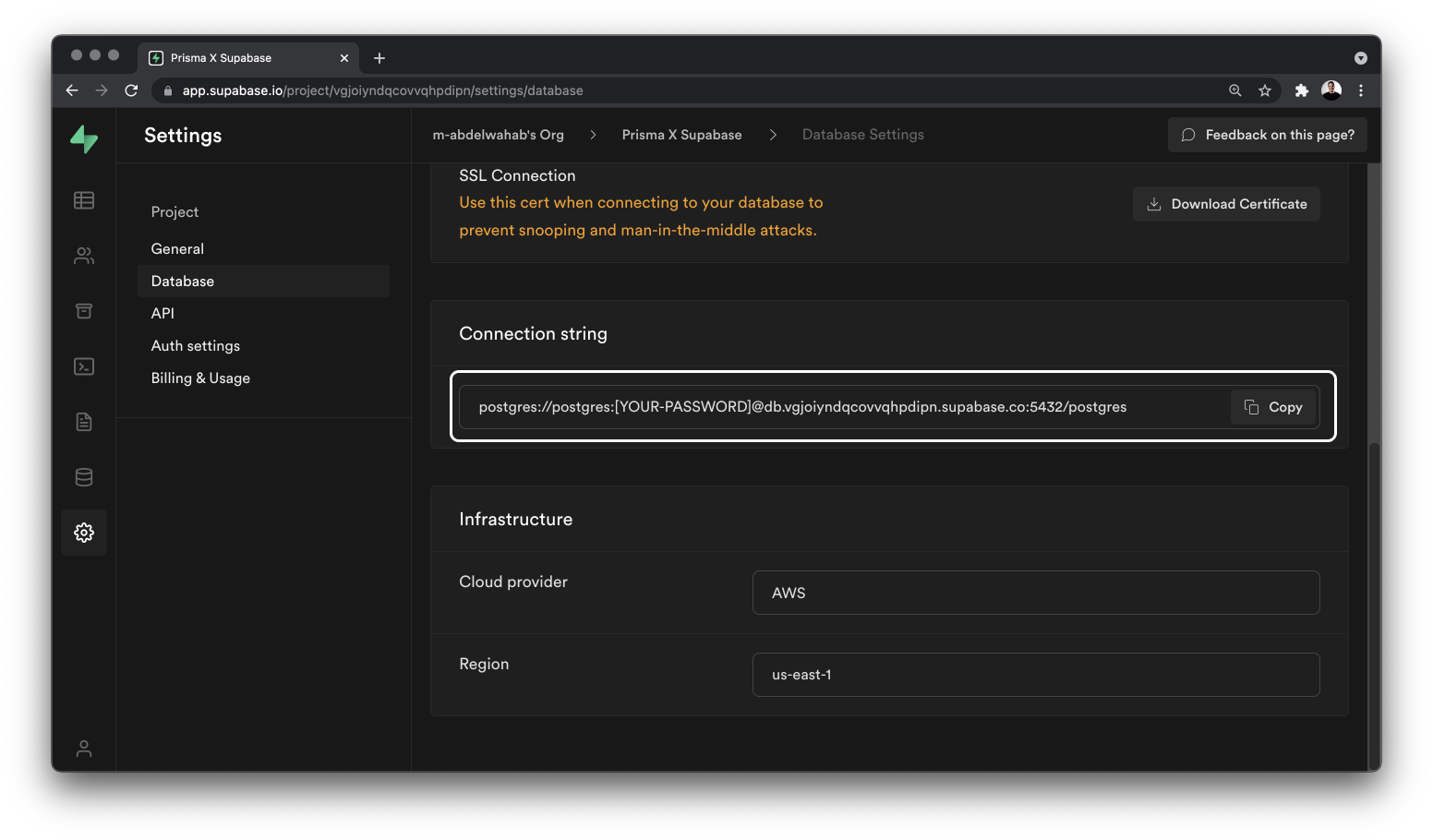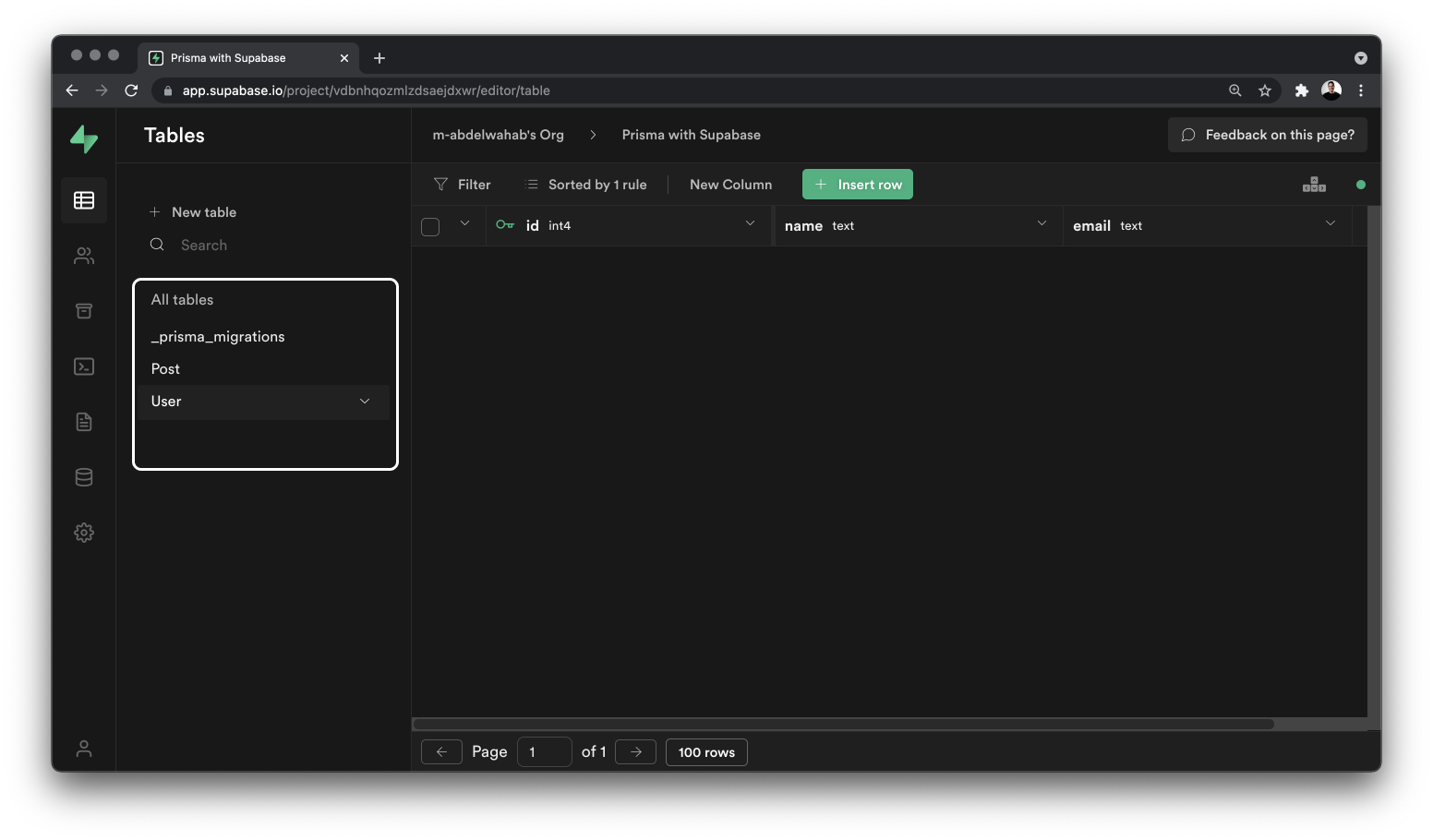Prisma
Overview
Prisma is an open source next-generation ORM. It consists of the following parts:
- Prisma Client: Auto-generated and type-safe query builder for Node.js & TypeScript.
- Prisma Migrate: Migration system.
- Prisma Studio: GUI to view and edit data in your database.
Documentation
This guide explains how to quickly connect the Postgres database provided by Supabase to a Prisma project.
Prisma is an open source next-generation ORM. It consists of the following parts:
- Prisma Client: Auto-generated and type-safe query builder for Node.js & TypeScript.
- Prisma Migrate: Migration system.
- Prisma Studio: GUI to view and edit data in your database.
Step 1: Get the connection string from Supabase project settings
Go to the settings page from the sidebar and navigate to the Database tab. You’ll find the database’s connection string with a placeholder for the password you provided when you created the project.

Step 2: Testing the connection
To make sure that everything works correctly, let’s try the connection string in a Prisma project.
If you already have one, all you need to do is set the DATABASE_URL to the connection string (including the password) in your .env file, and you’re good to go.
In case you don’t have a Prisma project or this is your first time working with Prisma, you’re going to use the repo from the quickstart guide.
Cloning the starter project
Navigate into a directory of your choice and run the following command in your terminal:
_10curl https://codeload.github.com/prisma/prisma-examples/tar.gz/latest | tar -xz --strip=2 prisma-examples-latest/databases/postgresql-supabase
You can now navigate into the directory and install the project’s dependencies:
_10cd postgresql-supabase_10npm install
A look at the project’s structure
This project comes with TypeScript configured and has the following structure.
- A
prismadirectory which contains:- A
seed.tsfile: This is the data used to seed your database. - A
schema.prismafile: Where you define the different database models and relations between them.
- A
- A
script.tsfile: where you will run some queries using Prisma Client.
This starter also comes with the following packages installed:
@prisma/client: An auto-generated and type-safe query builder that’s tailored to your data.prisma: Prisma’s command-line interface (CLI). It allows you to initialize new project assets, generate Prisma Client, and analyze existing database structures through introspection to automatically create your application models.
Note: Prisma works with both JavaScript and TypeScript. However, to get the best possible development experience, using TypeScript is highly recommended.
Configuring the project
Create a .env file at the root of your project:
_10touch .env
In the .env file, add a DATABASE_URL variable and add the connection string from step 1. The .env file should look like:
This is what your schema.prisma file should look like:
_24datasource db {_24 provider = "postgresql"_24 url = env("DATABASE_URL")_24}_24_24generator client {_24 provider = "prisma-client-js"_24}_24_24model Post {_24 id Int @id @default(autoincrement())_24 title String_24 content String?_24 published Boolean @default(false)_24 author User? @relation(fields: [authorId], references: [id])_24 authorId Int?_24}_24_24model User {_24 id Int @id @default(autoincrement())_24 email String @unique_24 name String?_24 posts Post[]_24}
To test that everything works correctly, run the following command to create a migration:
_10npx prisma migrate dev --name init
You can optionally give your migration a name, depending on the changes you made. Since this is the project’s first migration, you’re setting the --name flag to “init”. If everything works correctly, you should get the following message in your terminal:
_10Your database is now in sync with your schema._10:heavy_check_mark: Generated Prisma Client (4.x.x) to ./node_modules/@prisma/client in 111ms
This will create a prisma/migrations folder inside your prisma directory and synchronize your Prisma schema with your database schema.
Note: If you want to skip the process of creating a migration history, you can use the
prisma db pushcommand instead ofprisma migrate dev. However, we recommend usingprisma migrate devto evolve your database schema in development. If you would like to get a conceptual overview of how Prisma Migrate works and which commands to use in what environment, refer to this page in the Prisma documentation.
If you go to your Supabase project, in the table editor, you should see that two tables have been created, a Post, User, and _prisma_migrations tables. The _prisma_migrations table is used to keep track of the migration history and ensure that the database schema stays in sync with your Prisma schema.

That’s it! You have now successfully connected a Prisma project to a PostgreSQL database hosted on Supabase and ran your first migration.
Connection pooling with Supabase
If you’re working in a serverless environment (for example Node.js functions hosted on AWS Lambda, Vercel or Netlify Functions), you need to set up connection pooling using a tool like PgBouncer. That’s because every function invocation may result in a new connection to the database.
Supabase supports connection management using PgBouncer which prevents a traffic spike from overwhelming your database.
Go to the Database page from the sidebar in the Supabase dashboard and navigate to Connection pool settings:

When updating your database schema, you need to use the non-pooled connection URL (like the one used in step 1). You can configure the non-pooled connection string by using the directUrl property in the datasource block.
Update your .env file with the following changes:
- Rename the
DATABASE_URLenvironment variable toDIRECT_URL - Create a
DATABASE_URLenvironment variable and paste in the new connection string from the dashboard as its value
Append the ?pgbouncer=true flag to the DATABASE_URL variable.
Your .env file should resemble the following:
Update your Prisma schema by setting the directUrl in the datasource block:
_10datasource db {_10 provider = "postgresql"_10 url = env("DATABASE_URL")_10 directUrl = env("DIRECT_URL")_10}
Note: This feature is available from Prisma version 4.10.0 and higher.
If you want to learn more about Prisma, check out the docs. Also in case you have any questions or run into any issue, feel free to start a discussion in the repo’s discussions section.
Troubleshooting
Missing grants
If your database schema is out of sync from your migration history, prisma migrate dev will detect a migration history conflict or a schema drift. When prisma migrate dev detects the drift, it might ask to to reset your database schema. If you choose yes, it will delete the public schema along with the default grants defined in your database.
If you run into this problem, create a draft migration using prisma migrate dev --create-only, and add the following helper SQL:
_10grant usage on schema public to postgres, anon, authenticated, service_role;_10_10grant all privileges on all tables in schema public to postgres, anon, authenticated, service_role;_10grant all privileges on all functions in schema public to postgres, anon, authenticated, service_role;_10grant all privileges on all sequences in schema public to postgres, anon, authenticated, service_role;_10_10alter default privileges in schema public grant all on tables to postgres, anon, authenticated, service_role;_10alter default privileges in schema public grant all on functions to postgres, anon, authenticated, service_role;_10alter default privileges in schema public grant all on sequences to postgres, anon, authenticated, service_role;
Run prisma migrate dev to apply the draft migration to the database.
Using Supabase Auth with Prisma
If you would like to use Supabase Auth and Prisma in your application, you will have to enable the multiSchema Preview feature flag in the generator block of your Prisma schema:
_10datasource db {_10 provider = "postgresql"_10 url = env("DATABASE_URL")_10 directUrl = env("DIRECT_URL")_10}_10_10generator client {_10 provider = "prisma-client-js"_10 previewFeatures = ["multiSchema"]_10}
Next, specify the database schemas you would like to include in your Prisma schema:
_11datasource db {_11 provider = "postgresql"_11 url = env("DATABASE_URL")_11 directUrl = env("DIRECT_URL")_11 schemas = ["public", "auth"]_11}_11_11generator client {_11 provider = "prisma-client-js"_11 previewFeatures = ["multiSchema"]_11}
You can then specify what schema a model or enum belongs to using the @@schema attribute:
_10model User {_10 id Int @id_10 // ..._10_10 @@schema("auth") // or @@schema("public")_10}
To learn more about using Prisma with multiple database schemas, refer to this page in the Prisma docs.
Using PostgreSQL Row Level Security with Prisma
If you would like to use Row Level Security (RLS) with Prisma, check out the Prisma Client Extension - Row Level Security example that provides the primitives you could use to build and extend Prisma Client in PostgreSQL.
Also check out useSupabaseRowLevelSecurity Prisma Client extension that supports Supabase RLS and policies written to use Supabase auth.
The example and extension use Prisma Client extensions Preview feature.
Enabling PosgreSQL extensions
If you would like to use a PostgreSQL extension with Prisma, enable the postgresqlExtensions Preview feature flag in the generator block of your Prisma schema:
_10datasource db {_10 provider = "postgresql"_10 url = env("DATABASE_URL")_10 directUrl = env("DIRECT_URL")_10}_10_10generator client {_10 provider = "prisma-client-js"_10 previewFeatures = ["postgresqlExtensions"]_10}
Next, specify the extensions you need in the datasource block:
_11datasource db {_11 provider = "postgresql"_11 url = env("DATABASE_URL")_11 directUrl = env("DIRECT_URL")_11 extensions = [hstore(schema: "myHstoreSchema"), pg_trgm, postgis(version: "2.1")]_11}_11_11generator client {_11 provider = "prisma-client-js"_11 previewFeatures = ["postgresqlExtensions"]_11}
To learn more about using Prisma with PostgreSQL extensions, refer to this page in the Prisma docs.
Resources
- Prisma official website.
- Prisma GitHub.
- Prisma documentation.